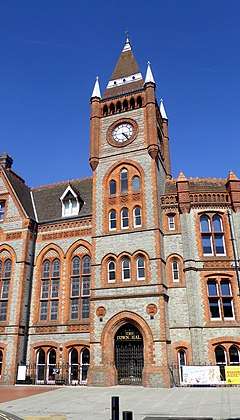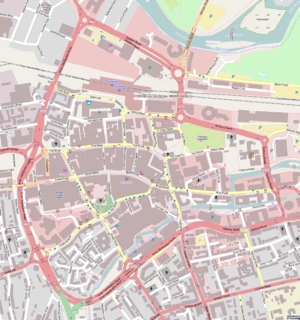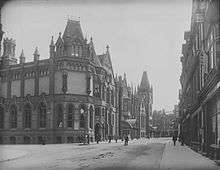Reading Town Hall
Reading Town Hall is the town hall for the town of Reading, in the English county of Berkshire. The town hall was built in several phases between 1786 and 1897, although the principal facade was designed by Alfred Waterhouse in 1875. Situated close to the site of Reading Abbey, it is adjoined to the north by the Hospitium of St John and to the south by St Laurence's Church.[1][2]
| Reading Town Hall | |
|---|---|
 | |
 Location within Reading Town Centre | |
| General information | |
| Type | Town hall |
| Architectural style | Italianate |
| Classification | |
Listed Building – Grade II* | |
| Designated | 22 March 1957 |
| Reference no. | 1113400 |
| Location | Reading, Berkshire, UK |
| Coordinates | 51.45695°N 0.97005°W |
| Construction started | 1786 |
| Completed | 1897 |
| Design and construction | |
| Architect | Alfred Waterhouse |
No longer the home of the town's administration, the Town Hall now houses the Reading Museum, a large concert hall, several smaller halls and conference rooms, and a public cafe. It is a listed building, with the block designed by Alfred Waterhouse being listed grade II*, whilst other parts of the building are listed grade II.[2][3][4][5][6]
History
The first recorded town or guild hall for Reading was known as the Yield Hall and is known to have been situated beside the River Kennet near the current Yield Hall Lane. However, by the middle of the 16th century this had proved too small, and the spoils of the dissolution of the monasteries were to provide both of the town's next two halls. Initially, in 1543, the town was granted part of the former friary that was later to become Greyfriars Church.[7]
However Greyfriars did not prove a successful town hall, and some twenty years later the council created a new town hall by inserting an upper floor into the former refectory of the Hospitium of St John, Reading Abbey's hospitium. The lower floor of this building continued to be used by Reading School, as it had been since 1486. For the next 200 years, the old monastic building continued to serve as Reading's town hall, but by the 18th century it was suffering from structural weakness.[8][9]

Between 1785 and 1786, the old hall was dismantled and replaced on the same site by the first of several phases of building that were to make up today's Town Hall. This part of the building later became known as the Small Town Hall or the Victoria Hall, to distinguish it from the much later concert hall. The new hall was designed by Alderman Charles Poulton, a cabinet maker by trade, and is today largely hidden behind later extensions. The rear elevation and four sash windows with semi-circular tops can be seen from St Laurence's churchyard.[1][4][9]
In 1864, the 1780s building was redecorated in an Italianate style by W H Woodman, the borough surveyor. At the same time an organ, built by Father Willis and presented by the Reading Philharmonic Society, was installed.[1][4][10]
In 1875, an extension and new frontage was designed in Victorian Gothic style by the architect Alfred Waterhouse, involving partial demolition of the 1780s building but retaining the core hall. The new frontage was built with red and grey bricks, together with terracotta ornaments, all of which were products of the town's Colliers' brickworks. This extension added a council chamber and offices to the building, and the clock tower over its entrance is still a distinctive Reading landmark.[1][3][10]
Alfred Waterhouse was subsequently asked to design a further extension including a new concert hall, museum and library, but this was thought too expensive. Instead the council decided to hold a design competition, and this was won by Thomas Lainson with a design that continued Waterhouse's Gothic styling. Again an Italianate style was used for the interior, and Lainson designed a new Baroque style case for the organ, which was enhanced and relocated into the new concert hall. The concert hall opened in 1882, and was followed by the museum and library in 1883-4.[1][5][10]

A final extension opened in 1897 and contained an extension to the library and an art gallery. This was designed by W R Howell, and includes the frontage on Valpy Street. In 1943, the southern end of the building suffered serious damage during an air raid. The scars of this attack remained visible until the restoration work of the 1990s.[1][10][11]
By 1951 the administration of the town had overflowed the available offices in the Town Hall, and the council decided to build new civic offices. Finally in 1976, the civic offices moved out to the newly built Reading Civic Centre. In 1985 the library moved to a new central library building on King's Road, leaving only the museum and concert hall in use. After some debate, plans to demolish the Town Hall and replace it with a new cultural centre were dropped, and in 1986 refurbishment of the building started with the closure of the concert hall. The refurbishment was completed in 2000, bringing the concert hall back into use and providing several new galleries for the museum and art gallery.[1][12]
References
- "Reading Town Hall" (PDF). Reading Museum Service. Retrieved 8 September 2010.
- "Town Hall". Reading Arts. Reading Borough Council. Retrieved 8 September 2010.
- Historic England. "Town Council Chamber and Offices with Clock Tower (1113400)". National Heritage List for England. Retrieved 12 December 2014.
- Historic England. "Small Town Hall (1321989)". National Heritage List for England. Retrieved 12 December 2014.
- Historic England. "Municipal Buildings – Concert Hall (1113401)". National Heritage List for England. Retrieved 12 December 2014.
- Historic England. "Municipal Buildings – Art Gallery and Museum (1321990)". National Heritage List for England. Retrieved 12 December 2014.
- Phillips, Daphne (1980). The Story of Reading. Countryside Books. p. 37. ISBN 0-905392-07-8.
- Phillips, Daphne (1980). The Story of Reading. Countryside Books. p. 42. ISBN 0-905392-07-8.
- Phillips, Daphne (1980). The Story of Reading. Countryside Books. p. 88. ISBN 0-905392-07-8.
- Phillips, Daphne (1980). The Story of Reading. Countryside Books. pp. 134–5. ISBN 0-905392-07-8.
- Phillips, Daphne (1980). The Story of Reading. Countryside Books. pp. 158–9. ISBN 0-905392-07-8.
- Phillips, Daphne (1980). The Story of Reading. Countryside Books. pp. 168–9. ISBN 0-905392-07-8.
External links
| Wikimedia Commons has media related to Reading Town Hall. |